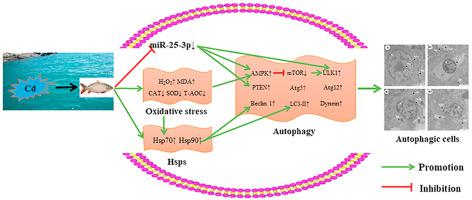当前位置:
X-MOL 学术
›
Environ. Pollut.
›
论文详情
Our official English website, www.x-mol.net, welcomes your feedback! (Note: you will need to create a separate account there.)
The contributions of miR-25-3p, oxidative stress, and heat shock protein in a complex mechanism of autophagy caused by pollutant cadmium in common carp (Cyprinus carpio L.) hepatopancreas
Environmental Pollution ( IF 8.9 ) Pub Date : 2021-06-10 , DOI: 10.1016/j.envpol.2021.117554 Zhuo Li 1 , Syed Waqas Ali Shah 1 , Qin Zhou 1 , Xiujie Yin 1 , Xiaohua Teng 2
Environmental Pollution ( IF 8.9 ) Pub Date : 2021-06-10 , DOI: 10.1016/j.envpol.2021.117554 Zhuo Li 1 , Syed Waqas Ali Shah 1 , Qin Zhou 1 , Xiujie Yin 1 , Xiaohua Teng 2
Affiliation

|
Cadmium (Cd) is a toxic heavy metal that can be discharged into water environment through industrial activities, threatening the health of aquatic organisms and humans. MicroRNA (miRNA) plays an important role in the process of autophagy. The purpose of this experiment was to study the mechanism of Cd-induced autophagy in common carp hepatopancreas. We established a Cd poisoning model of common carp and explored ultrastructure, two oxidation indicators, three antioxidant indicators, , two heat shock proteins (Hsps), and nine autophagy-related genes. The results confirmed that deleterious effect of Cd caused the injury of hepatopancreas and the appearance of hepatopancreas autophagic cells in common carp. At the same time, Cd exposure increased the contents of hydrogen peroxide (HO) and malonaldehyde (MDA), and decreased the activities of catalase (CAT), superoxide dismutase (SOD), and total antioxidative capacity (T-AOC), meaning that Cd caused oxidative stress via the imbalance between peroxide level and antioxidant capacity. Moreover, exposure to Cd increased mRNA expression of (), , , (), and (); and decreased mRNA expression of (), indicating that excess Cd caused autophagy, and AMPK/mTOR/ULK1 signaling pathway took part in autophagy induced by Cd in common carp hepatopancreas. Furthermore, Cd down-regulated and up-regulated its three target genes (, as well as ), suggesting that mediated autophagy induced by Cd. In addition, we found that Hsps were activated via the up-regulation of and . Moreover, oxidative stress mediated autophagy via Hsps in Cd-treated common carp hepatopancreas and Cd-induced autophagy was time dependent. In summary, , oxidative stress, and Hsps participated in autophagy caused by Cd in common carp hepatopancreas. This study provided a new idea for the mechanism of Cd-induced autophagy in hepatopancreas.
中文翻译:

miR-25-3p、氧化应激和热休克蛋白在污染物镉引起的鲤鱼(Cyprinus carpio L.)肝胰腺自噬复杂机制中的作用
镉(Cd)是一种有毒重金属,可通过工业活动排放到水环境中,威胁水生生物和人类的健康。 MicroRNA(miRNA)在自噬过程中发挥着重要作用。本实验的目的是研究Cd诱导鲤鱼肝胰腺自噬的机制。我们建立了鲤鱼镉中毒模型,并探索了超微结构、两个氧化指标、三个抗氧化指标、两个热休克蛋白(Hsps)和九个自噬相关基因。结果证实Cd的有害作用导致鲤鱼肝胰腺损伤和肝胰腺自噬细胞的出现。同时,Cd暴露增加了过氧化氢(H2O)和丙二醛(MDA)的含量,降低了过氧化氢酶(CAT)、超氧化物歧化酶(SOD)和总抗氧化能力(T-AOC)的活性,这意味着镉通过过氧化物水平和抗氧化能力之间的不平衡引起氧化应激。此外,暴露于 Cd 会增加 ()、、、、() 和 () 的 mRNA 表达; ()的mRNA表达降低,说明过量的Cd引起了鲤鱼肝胰腺自噬,AMPK/mTOR/ULK1信号通路参与了Cd诱导的自噬。此外,Cd 下调和上调其三个靶基因(以及 ),表明 Cd 介导自噬。此外,我们发现 Hsps 通过 和 的上调被激活。此外,在镉处理的鲤鱼肝胰腺中,氧化应激通过热休克蛋白介导自噬,并且镉诱导的自噬具有时间依赖性。综上所述,氧化应激和热休克蛋白参与了Cd引起的鲤鱼肝胰腺自噬。该研究为Cd诱导肝胰腺自噬的机制提供了新思路。
更新日期:2021-06-10
中文翻译:

miR-25-3p、氧化应激和热休克蛋白在污染物镉引起的鲤鱼(Cyprinus carpio L.)肝胰腺自噬复杂机制中的作用
镉(Cd)是一种有毒重金属,可通过工业活动排放到水环境中,威胁水生生物和人类的健康。 MicroRNA(miRNA)在自噬过程中发挥着重要作用。本实验的目的是研究Cd诱导鲤鱼肝胰腺自噬的机制。我们建立了鲤鱼镉中毒模型,并探索了超微结构、两个氧化指标、三个抗氧化指标、两个热休克蛋白(Hsps)和九个自噬相关基因。结果证实Cd的有害作用导致鲤鱼肝胰腺损伤和肝胰腺自噬细胞的出现。同时,Cd暴露增加了过氧化氢(H2O)和丙二醛(MDA)的含量,降低了过氧化氢酶(CAT)、超氧化物歧化酶(SOD)和总抗氧化能力(T-AOC)的活性,这意味着镉通过过氧化物水平和抗氧化能力之间的不平衡引起氧化应激。此外,暴露于 Cd 会增加 ()、、、、() 和 () 的 mRNA 表达; ()的mRNA表达降低,说明过量的Cd引起了鲤鱼肝胰腺自噬,AMPK/mTOR/ULK1信号通路参与了Cd诱导的自噬。此外,Cd 下调和上调其三个靶基因(以及 ),表明 Cd 介导自噬。此外,我们发现 Hsps 通过 和 的上调被激活。此外,在镉处理的鲤鱼肝胰腺中,氧化应激通过热休克蛋白介导自噬,并且镉诱导的自噬具有时间依赖性。综上所述,氧化应激和热休克蛋白参与了Cd引起的鲤鱼肝胰腺自噬。该研究为Cd诱导肝胰腺自噬的机制提供了新思路。



























 京公网安备 11010802027423号
京公网安备 11010802027423号